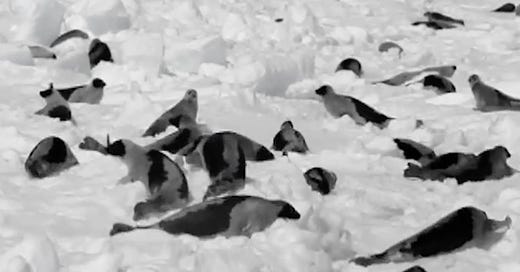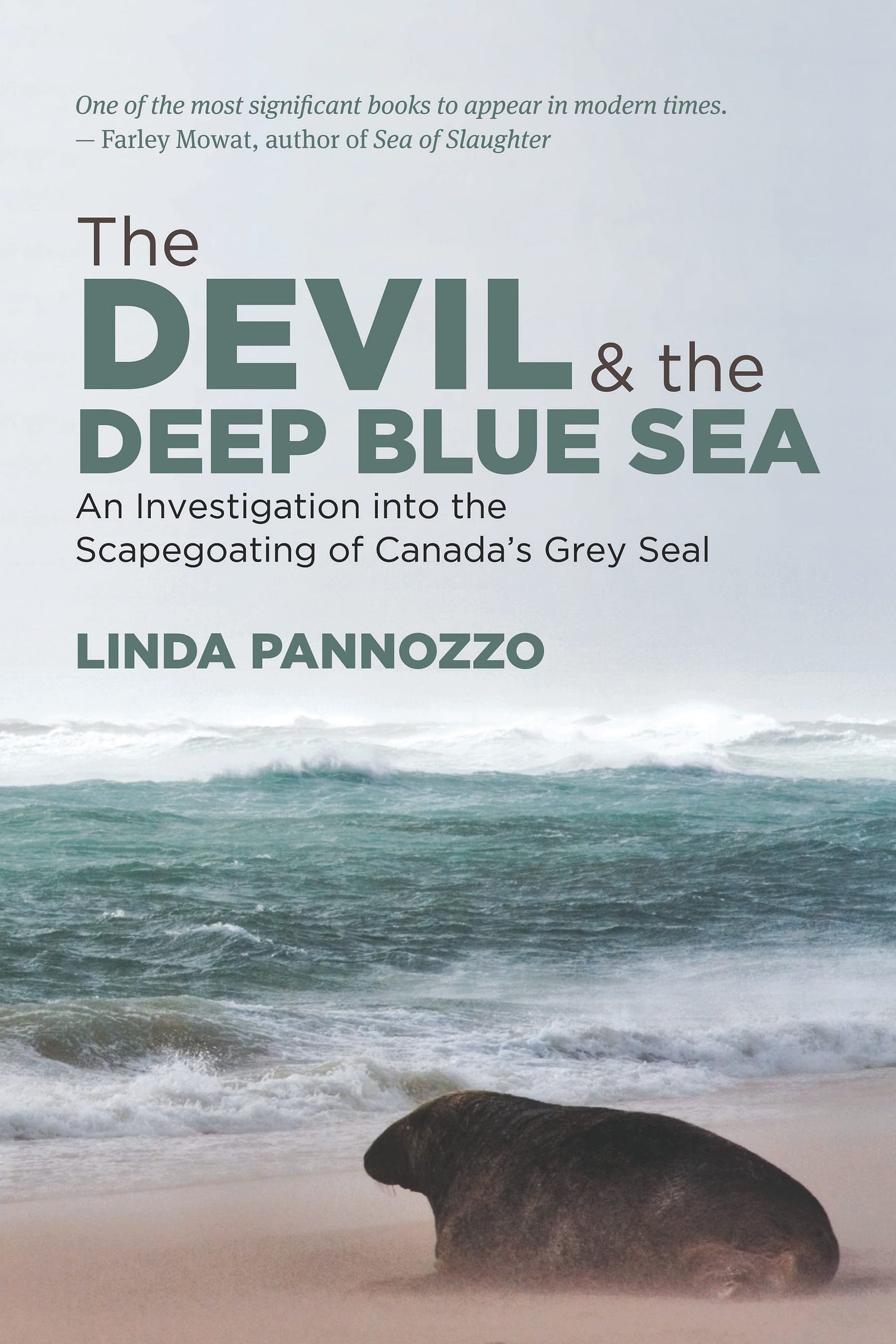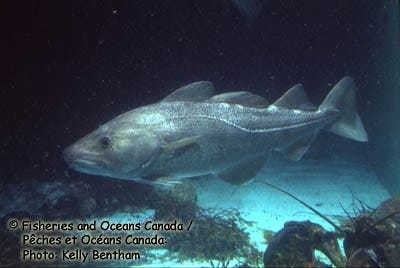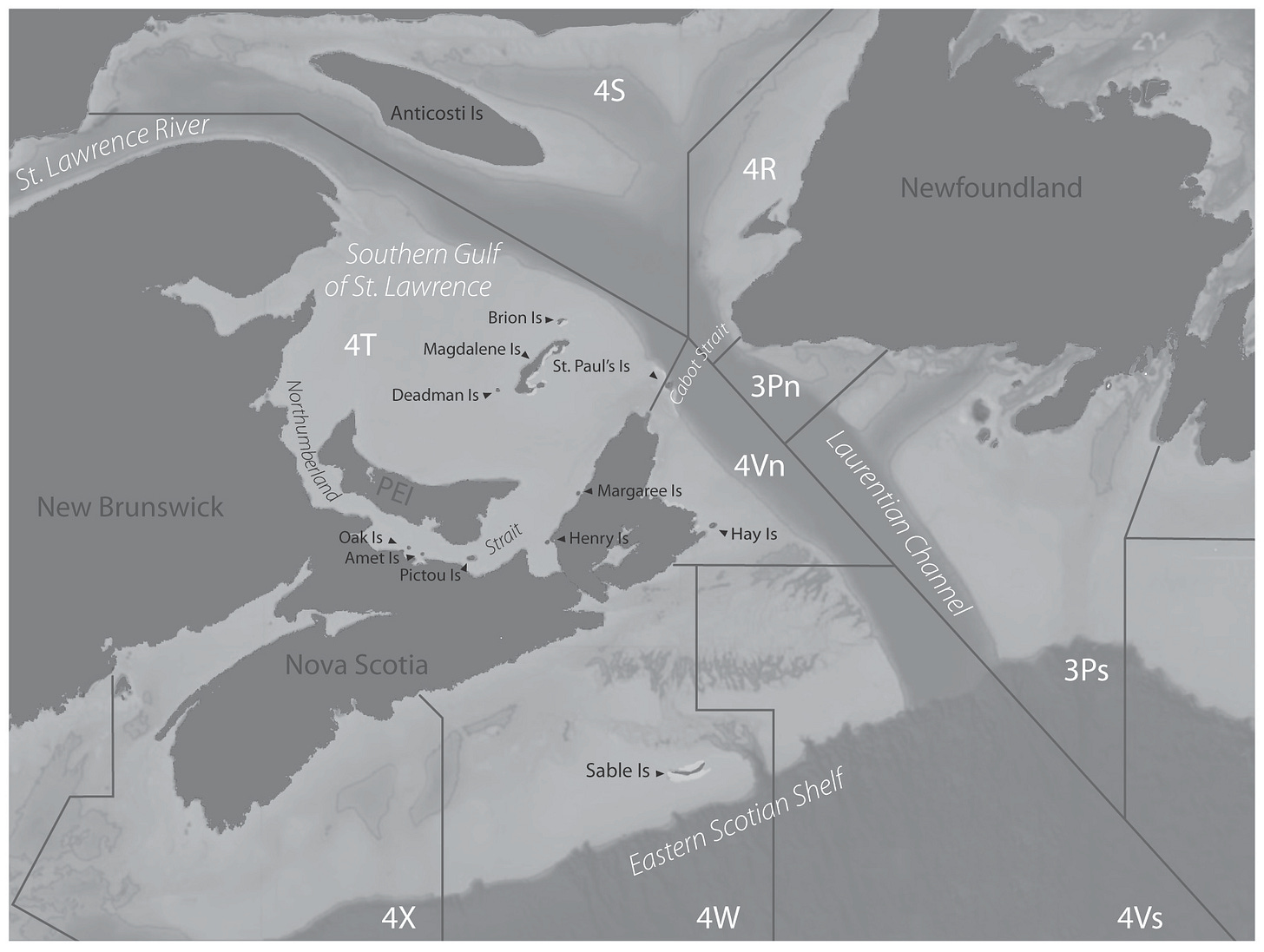The Devil is in the Details
Part 1: Fish Harvesters' Union Wages Disinformation Campaign about Seals
The biomass of fishes that eat cod is much bigger than seals. But seals are physically much bigger—they lie on the beaches and we can see them. It’s like looking for a key under a street lamp. -- Daniel Pauly, Fisheries Scientist, University of British Columbia
About a month ago, the Fish, Food & Allied Workers Union (FFAW-Unifor) launched a nationwide “awareness campaign” to “call attention to seal overpopulation in Atlantic Canada and the devastating effects on fish stocks.”
As part of its campaign, they produced a video, which makes an astonishing claim. “And the truth is this: fish harvesters are not ravaging our fishery, and destroying our ocean ecosystem, seals are.”
Screenshot taken from Fish, Food & Allied Workers Union campaign video
The organization wants the federal government to study the “true impact seals are having on our coasts, and to ensure appropriate action is taken to repair the ecosystem imbalance.”
In its media release, FFAW do not address (or even mention) how overfishing resulted in the collapse of the groundfish in the early 1990s, or about the impact that fishing today might be having on already beleaguered stocks. No, they only point to “uncontrolled seal populations” as a threat to the rebuilding of stocks. “They threaten the sustainability of our fishing industry, and they threaten the health of our ocean.”
That the grey seals are the smoking gun in the non-recovery of stocks is based on the following calculation:
“An adult grey seal can consume up to two tonnes of prey each year. With an estimated 400,000 grey seals, that amounts to 800,000 tonnes of prey consumed annually.”
The fish harvesters’ group provides a similar argument for a similar threat posed by harp seals:
“Harp seals are estimated at over 7.6 million in Atlantic Canada, and the last assessment in 2008 estimated the consumption of 4.2 million tonnes of prey each year. Between 1992 and 2022, the entire commercial fishery in Newfoundland and Labrador harvested less Atlantic cod than seals are estimated to consume each year.”
In my 2013 book titled The Devil and the Deep Blue Sea: An Investigation into the Scapegoating of Canada’s Grey Seal, I explored the relationship between grey seals and cod. I wrote the book because at the time there were growing calls by the fishing industry, politicians, and even some scientists for a massive cull of the grey seal population. The species had gloriously rebounded from near extirpation and instead of being considered a conservation success story, it was seen as a blight for eating too many cod, a species that had not recovered despite a moratorium followed by limited fishing effort. There was little if any science to support the connection, let alone a cull. But the narrative had legs. It was a stark reminder of how fisheries science and public policy were becoming increasingly estranged from each other.
Needless to say, after the book was published, I had hoped the issue was finally put to rest, and that science—the kind that acknowledges not only the complexity but the daunting gaps in knowledge—had finally prevailed.
But it appears the respite was short-lived. I’m not really surprised. In my book I noted that scapegoating seals—the practice of assigning blame that is not based on facts—provides a powerful distraction from a number of public policy issues in the fisheries that we should really be rallying over. Scapegoating in this case is also motivated by another powerful reality: the vast majority of the world’s fisheries are either fully exploited, overexploited, or depleted. There is a relationship between the availability of fish stocks and the prevailing attitudes among fishers towards seals. Scapegoating is a response to this scarcity and a perceived threat to profits.
A few weeks ago, I sent a series of questions to Courtney Glode—who is listed as the media contact for FFAW-Unifor, but have yet to receive a response.
In my 2016 book I covered a lot of this ground. The narrative hasn’t changed, and I have a suspicion that the diet study FFAW used for its calculations is the same (sketchy) one that’s been around for awhile.
This 3-part series will reproduce the chapter titled, “The Devil is in the Details,” which specifically delved into seal diet studies, including the one that likely informs statements like the one FFAW-Unifor made above about fish consumption by seals.
But first, let’s explore what might have happened in the ocean ecosystem when we wiped out almost all groundfish species by overfishing them.
The Quest to Understand an Invisible World
The early 1990s didn’t just mark the collapse of cod. It marked a gigantic shift in the structure of the ocean ecosystem. Almost all groundfish species with any commercial value were wiped out: haddock and pollock took a big hit and so did the flatfishes like Atlantic halibut, Greenland halibut (turbot), American plaice and yellowtail flounder. Thorny skate, cusk, grenadiers, silver hake, white hake, wolffish, redfish, lumpfish and monkfish didn’t es- cape the draggers either. Industrial fishing ravaged the biological structure of the marine ecosystem to such an extent that scientists are still trying to understand the fallout.
As we have seen, two decades after the crash, the cod stocks, as well as other fish stocks, still remain at very low levels, while the grey seals are enjoying a conspicuous recovery. No matter where one stands on the issue, one has to admit the optics are not very good. Proponents of a cull have boiled the intricacies of the marine food web down to one simple mathematical equation: less seals equals more cod. Key to implicating the grey seals has been to show that they are eating enough cod to affect the cod recovery. These diet data are also used to work out how many grey seals should be killed, should a cull be authorized. But as we shall see, not only are there limitations to the methods used for analyzing what individual grey seals eat, but seal diet experts argue that using these data to then come up with a diet for the whole population is nothing short of misleading.
Rachel Carson may be best known for her seminal 1962 book Silent Spring — a call to action against the pesticides that were devastating bird populations — but she was first and foremost a naturalist. Her early career began as a marine biologist with the U.S. Bureau of Fisheries and her love of the marine environment and the life it contained was never more evident than in her 1941 book Under the Sea Wind: A Naturalist’s Picture of Ocean Life. In this book, Carson presents a vivid and beautifully written narrative of the rich and interconnected lives of a myriad of creatures found in and around the Atlantic Ocean off the northeast coast of the United States. About a third of the way into the book, she introduces us to a mackerel she calls Scomber, which is the scientific name for the genus that includes the Atlantic mackerel, a schooling fish that lives in the open ocean. Carson takes us on Scomber’s journey, starting from the time it was one of the forty or fifty thousand eggs released by its mother during the spring spawn to the moment it is born in the surface waters of the open sea, and ending with its transformation into an adult fish:
On the journey up the coast, the heavy, unmoulded lines of a larval fish had been sculpted to a torpedo-shaped body with a hint of power in the shoulders and a speed in the tapering flanks. Now he had put on the sea coat of the adult mackerel. He was clothed in scales, but they were so fine and small that he was soft as velvet to the touch. His back was a deep blue green — the colour of the deep places of the sea that Scomber had not yet seen.
What is perhaps most remarkable about Carson’s narrative about Scomber’s life, and indeed the individual lives of all the fish in her book, is how beautiful and visible she makes it. She shows us how Scomber’s life, hidden from view beneath the ocean, is intertwined with that of the sea birds, as well as with the tiny one-celled organisms and of course, with other fish. She shows us part of an ocean food web, its complexity and, when intact, its stability. We relate to Scomber and we even root for him. We become worried when he encounters a two-hundred-pound, six-foot cod, hiding on a ledge among some rockweed:
The cod had grown old and very large because of his cunning. He had found the rock ledge above the deep pit of the sea years before and, knowing it instinctively for a good hunting place, he had ad- opted the ledge for his own, fiercely driving away the other cod.... Many fishes met their death in his jaws, among them cunners and hook-eared sculpins, sea ravens with ragged fins, flounders and sea robins, blennies and skates. Sight of the young mackerel roused the cod from the semi-torpor in which he had lain since the last feeding time and kindled his hunger. He swung his heavy body out of the ledge and climbed steeply to the shoal. Scomber fled before him.
Cod was definitely king among fish at that time: some scientists have hypothesized that it was dominant for a reason. In 2001, fisheries scientist Carl Walters of the University of British Columbia (UBC) and zoologist James Kitchell of the University of Wisconsin said that adults of a dominant fish species are abundant predominantly because they “crop down” forage fish — the term used for the small fish on which they prey — which are also potential competitors and predators of their own juveniles. So, for example, the monster cod hiding in the rockweed in Carson’s book has to eat Scomber, because Scomber is a forage fish, feeding mainly on drifting communities of life: tiny crustaceans called copepods, and fish eggs, including that of cod. As Scomber gets older he adds small fish, including codlings and even young mackerel, to his diet. If the big cod eats Scomber — and he doesn’t in Carson’s book — it removes a fish that would potentially prey on or compete with its young, reinforcing its dominant position in the ocean ecosystem. Walters and Kitchell call this a “cultivation effect.”
However, there is a flip side. What happens if the numbers of the adults in the dominant species, in this case cod, are reduced by overfishing? Essentially, when there are no cod, the condition of the ecosystem turns against the cod. It’s called the depensation effect, which in ecological terms simply means that when there are very low numbers of a species, their chances of survival are much reduced.
When it comes to the current situation, where the cod have not bounced back, some scientists say the problem has to do with the high natural mortality of the adult fish. They argue that the cod are in a “predator-pit,” and that their population is being kept low by other predators — in this case, grey seals. These scientists say the growing grey seal population is the most likely cause for the non-recovery in the southern Gulf of St. Lawrence — a subject and a particular set of circumstances to which we’ll return in the next chapter. Another possible explanation for the cod non-recovery, which is still consistent with the hypothesis put forth by Walters and Kitchell in 2001, is that, on the eastern Scotian Shelf, in the vicinity of Sable Island, there’s been a “predator-prey reversal,” so that, when cod lost its place as a top predator, its prey populations increased in abundance, with the result that these fish, which are predators of cod eggs and young cod, have held back the recovery. While each of these hypotheses is fervently advocated by some and attacked by others, there is no question that something is going on.
In 2011, DFO scientist Ken Frank and his colleagues reported in Nature that the groundfish collapse on the eastern Scotian Shelf resulted in a re- structuring of the entire food web, with evidence of what’s called a “trophic cascade,” a phenomenon that occurs when a succession of fundamental changes make their way through the trophic levels of the food web, eventually to the tiniest life forms — the plankton.[1] In this case, Frank and his colleagues reported that the loss of the cod set in motion two key patterns. One involved the invertebrates and the other, the forage fish.
Invertebrates, such as shrimp and small crab, were reported to have surged by 200 percent compared to pre-collapse years — a boom that was reflected in their commercial landings. This is because, in a marine food web, the lives of cod and invertebrates, such as shrimp, are connected. Hatched- out shrimp eggs drift in both the deep and surface layers of the ocean; once they are a few months old they move into deeper waters, finally settling on the ocean floor, the primary domain of the cod. However, when the cod collapsed, this freed the shrimp from predation, and their numbers increased. Since shrimp will eat the egg and larval stages of cod during their nocturnal migration up the water column in search of small crustaceans, this played a role in keeping the cod down.[2]
Frank and his colleagues also argued that the population of the forage fish — namely herring, capelin, and sandlance — erupted in the mid-1990s, reaching levels 900 percent higher than pre-collapse levels. These were also implicated in the sluggish recovery because they eat the egg and larval stages of cod. But recently, the forage fish complex, a key element of the trophic cascade hypothesis, has come under some scrutiny.
Northwest Atlantic Fisheries Organization (NAFO) fishery management areas and main grey seal pupping colonies in Atlantic Canada.
In 2009, DFO scientist Ian McQuinn raised concern about the way in which forage fish — particularly herring — abundance was being measured. He wrote that the trophic cascade linkages could not have been made without the forage fish abundance data from the DFOs annual bottom trawl survey data. According to McQuinn, these data are misleading for a couple of reasons. First, herring and other forage fish such as sandlance and mackerel are open ocean fish — “pelagic” is the scientific term used — and their abundance really should be measured, for the sake of accuracy, with hydro- acoustic surveys, a method in which underwater sound pulses are used to detect objects, such as fish, in the water column: the echoes produced provide information on fish size, location, abundance and behaviour. But very little hydro-acoustic data have been gathered here, and then only sporadically.
Second, pelagic fish, like herring, don’t normally occupy the ocean bottom. However, according to McQuinn, around the same time that the cod collapsed, herring started behaving differently — occupying the bottom ocean layers, which had been “vacated by their diminishing groundfish predators” instead of forming their signature schools in the water column. As a result, DFOs bottom trawl survey was picking up an unusually high number of them: when this was extrapolated to come up with an overall abundance, it made it appear as though their numbers had spiked. McQuinn also pointed out that if the forage fish population had grown as much as was indicated by the bottom trawl, there should have been other signs of this explosion, like huge increases in landings (the quantity of fish caught) — as was the case with shellfish. Instead, landings in the herring fishery declined, despite higher quotas. In fact, when the bottom trawl survey was showing a two- hundred-fold increase in herring, the fishery was experiencing the opposite. Similarly, since grey seal diets are thought to reflect local prey abundance, then evidence of increases in forage fish would likely show up in seal diet studies; however, analysis of seal diet did not show any increasing trend in forage fish consumption.
Some of McQuinn’s misgivings about using the trawl data were echoed in 2012 by two other DFO scientists, Doug Swain and Robert Mohn. They also said that a focus on forage fish was irrelevant since the main factor causing the delay in recovery on the eastern Scotian Shelf was that too many adult cod were dying, not that too few codlings were surviving.
When it comes to the complex of forage fish on the Scotian Shelf, no estimate is reliable — it’s mostly speculation, says DFO population ecologist Jae Choi. He tells me that questions surrounding the forage fish data do weaken the trophic cascade hypothesis, but certainly don’t discredit it. He says the controversy highlights the uncertainty associated with our understanding of marine food webs and how we’re inclined to favour simple, even sensational, explanations that provide “a smoking gun” over more complex ones.
For instance, in 2004 Choi co-wrote a paper with Ken Frank and others reporting that over the last forty years on the eastern Scotian Shelf, dozens of groundfish species have been getting smaller and thinner and are in progressively poorer condition. The authors hypothesized that this was caused by “energy depletion in the system,” or a problem with food supply, probably as a result of decades of intensive fishing, which has removed an enormous supply of biomass — the organic matter that eventually breaks down and feeds the food web cycle. Choi says we have been “strip mining” for centuries and that “trawling has decimated the bottom cover to the point where there’s almost no substrate left.” He says that “there’s no complexity, essentially we’ve mined an area and expect it to return, but for that to regenerate it could take hundreds of years.”
Choi says we are now witnessing some of the cumulative effects. “When you remove the biomass, you’re removing the availability of elements that compose the animals — carbon, nitrogen, phosphorus, silica, iron, the key things,” he says, altering the quantity and quality of what’s available to the phytoplankton at the base of the food web. In his view, it is not unlike clearcutting a forest. In other words, the large-scale cumulative removal of fish, coupled with other changes in the system, might have led to a whole suite of pathological effects, including one that is difficult to fathom: that most large-bodied fish are physiologically stressed and some are even starving.
Choi’s hypothesis is rooted in an alternative view of how the food web is controlled. Unlike the “top-down” approach, which focuses on predation and basically says that species lower down in the food web are regulated by one or more predators higher up, this alternative view of the ocean ecosystem — from the “bottom-up” — contends that overall productivity is dependent on its tiniest parts, including the plants producing the food, and the precious supply of nutrients required to do so. In other words, changing the abundance of the tiny plant life called phytoplankton affects the abundance of the zooplankton, which would lead to changes in the abundance of prey fish and then of their predators.
Every marine species is influenced by a combination of forces, some of which we have yet to identify. Choi says the system is too complicated to even comprehend but the top-down approach provides some of the easiest answers. “You look for the smoking gun, and you try to control it. It’s a very reductionist western tradition — European and North American — to try to control things in that way, to engineer things to try to achieve a certain outcome. But it doesn’t always work.” In other words, pointing a finger at one culprit, whether it’s the forage fish or the grey seal, is easy and tempting but not likely to solve the cod’s problem.
[Part 2 of this series will look at the complexity of seal diet studies]
[1] Trophic levels are essentially the layers of a food web: an animal’s rank depends on how many steps it is from the primary producers — the phyto- plankton at the base of the food web or trophic level one. These microscopic, single-celled, free-floating plants take nutrients in the ocean and combine them with carbon dioxide and sunlight to manufacture their own food. All other ocean creatures need to eat other organisms for food. Depending on what they eat, they occupy a certain position, or trophic level, in the food web. This is further complicated by the fact that some consumers eat at multiple trophic levels, some organisms change their diets as they grow, and some species, such as cod, are cannibalistic. Most marine mammals, such as grey seals, occupy trophic levels three to five.
[2] Retired DFO shrimp expert Peter Koeller agrees, but he argues colder water temperatures in the late 1980s and early 1990s also contributed to the shrimp boom. In fact, so dependent are shrimp on water temperatures, that the international research project led by Koeller concluded in a 2009 study published in Science that shrimp stocks, now the mainstay of the east coast fishery, may be vulnerable as oceans warm as a result of climate change. Debbie MacKenzie of the Grey Seal Conservation Society has a different hypothesis for the surge in shrimp. She says that as we’ve fished out the open-ocean fish — the plankton-eaters — more un-eaten plankton rains down onto the bottom layers and gets eaten by shrimp.








So Timely. Again. Like so much of your research and writing, always seeking the facts. Thx LP.
A much needed reality check concerning the complexities of our ocean ecosystems in relation to the proposed cull.